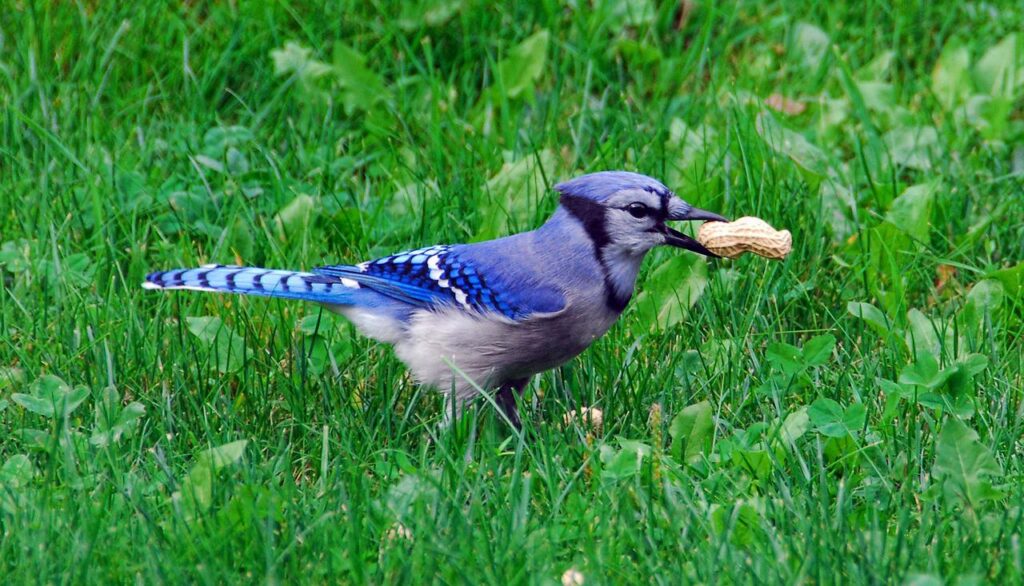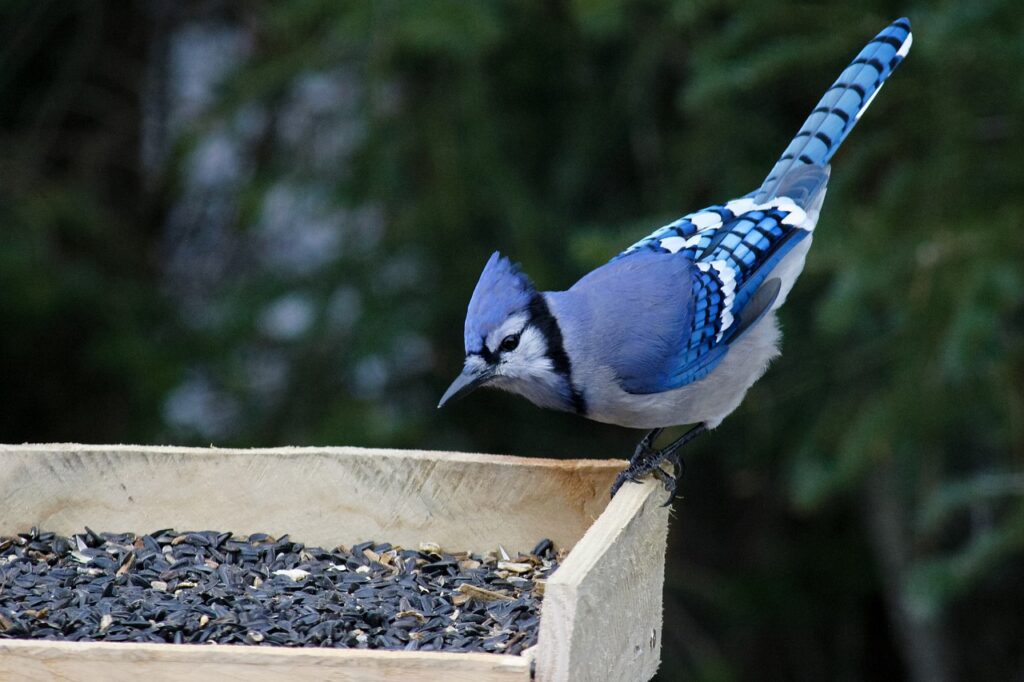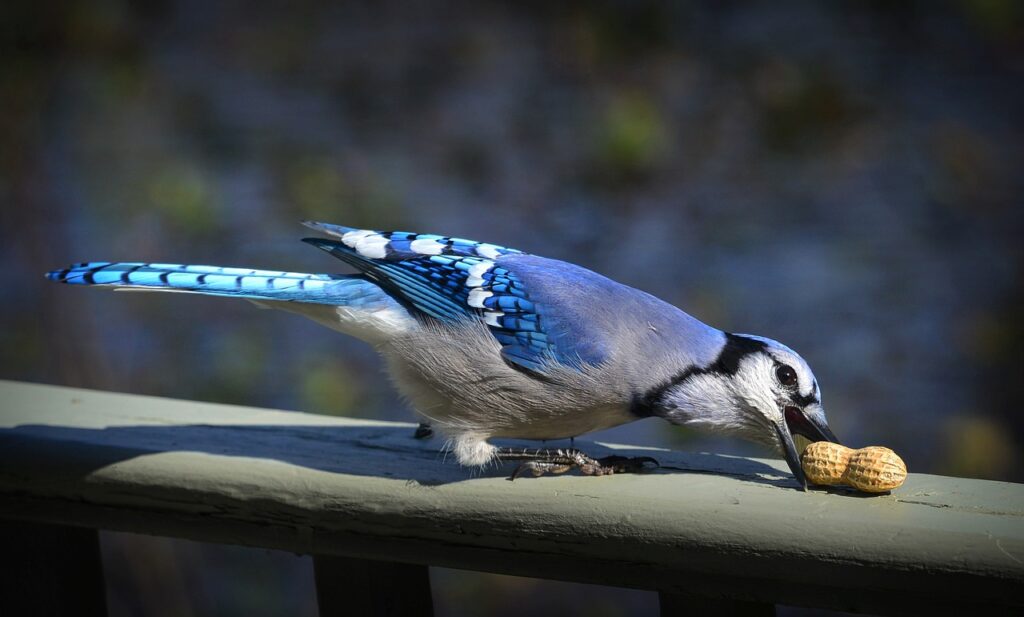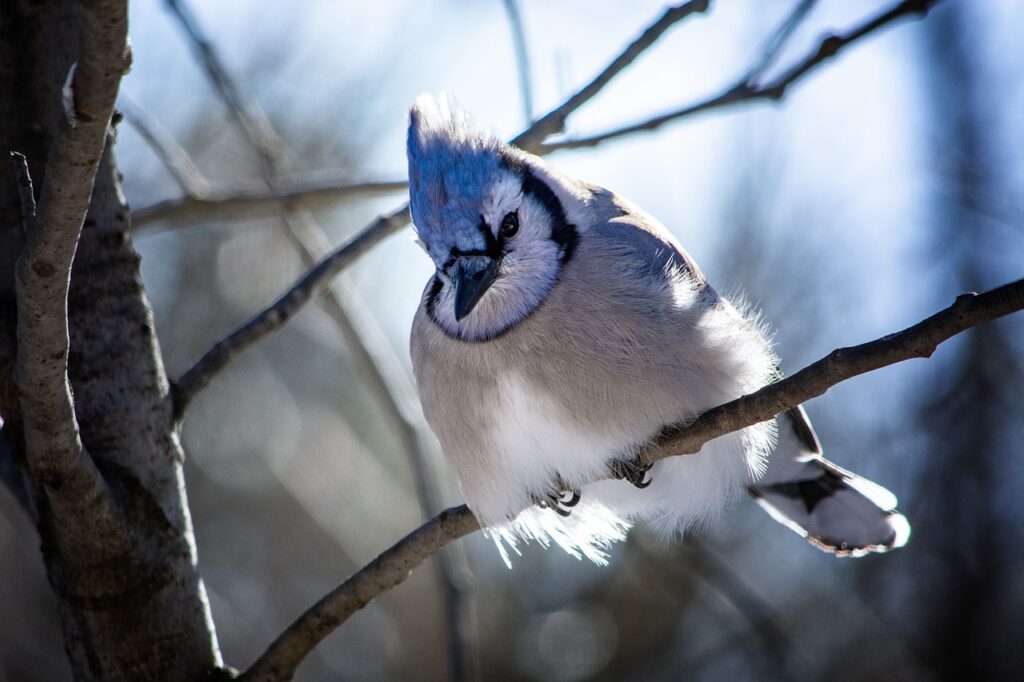Looking for a handful of fun Blue Jay facts? I wanted to put together a short post for one of my favorite birds at my feeders. I think Blue Jays get a lot of undeserved flack. There’s a perception that Blue Jays bully other birds, steal their eggs, and are generally aggressive. This viewpoint is overblown.
Blue Jays are larger and louder songbirds and can clear away birds from feeders occasionally. But, other birds like Red-Bellied Woodpeckers and Grackles actually bully Blue Jays at feeders in terms of hierarchy. It’s also been shown that gray squirrels will also prevent Blue Jays from feeding.
Blue Jays rarely eat eggs of other birds. A study referenced by Cornell Bird Lab on Blue Jay eating habits found that 1% of Jays had evidence of eggs in their stomachs. They usually eat what other songbirds eat, insects and seeds!
As you’ll see in one of the facts below, Blue Jays are actually dedicated parents and bring a lot of fun and unique personality to your yard. Read on for more facts on this intelligent and fascinating bird!
Related Content: 22 Unique Cardinal Facts You Didn’t Know About
Blue Jay Facts #1. They Hide and Store Food for Later

Blue Jays engage in a behavior called “caching“. They will grab food and hide it in various locations, sometimes burying it or hiding it in crevices of trees. This is fun to watch as a bird feeder. I see Blue Jays fly off with peanuts or sunflower seeds (their favorite feeder foods), dig them into the ground, and cover the spot with leaves. Blue Jays can remember the locations of dozens of caches. How they do so is a mystery, but it’s safe to say that they’re intelligent birds with impressive memories.
Blue Jay Facts #2. Blue Jays…Aren’t Actually Blue

One of the best aspects of Blue Jays is that they bring striking blue color to your yard and feeders.
However, Blue Jay feathers aren’t blue. They’re a drab brown-gray. We see them as blue because of light scattering, the reflection of light off their feathers from the sun.
The color blue is uncommon in nature. Any blue bird you see (Eastern Bluebirds, Indigo Bunting, etc.) is also not blue, it’s just an optical illusion trick right in nature.
Blue Jay Fact #3. They Have a Throat Pouch to Store Food In

Getting back to Blue Jay caching…part of what makes them great storers of food is that they can hold multiple seeds at once in a throat sack (lol) called the gular pouch. They can store up to five acorns at once in their throat.
This is a funny sight at feeders. You’ll see a Blue Jay stuff as many peanuts as it can into its throat before it flies away to store them for later.
That’s efficient eating! I wish I could do this, but I’d also rather not receive a lifetime ban from restaurants.
Blue Jay Fact #4. Blue Jays Copy the Calls of Hawks, Bald Eagles and Owls

Outside of their familiar loud screech-like calls, Blue Jays mimic other bird calls, especially red-shouldered hawks. They also copy Gulls, Osprey, Screech Owls, Coopers Hawks, and several other bird sounds.
The reason why isn’t certain. Some hypothesize that jays do it simply for territorial defense and to clear spaces of other birds when they want to feed. Others claim it helps jays stand out during mate selection…or they simply enjoy copying other sounds they hear.
Anecdotally speaking…I once saw a Blue Jay mimic a dog barking at my feeders before grabbing a peanut. It worked. All of the other birds at my feeder scattered.
Source: Ross D. James – Of Blue Jays and Mimicry
Blue Jay Fact #5. They Are Family-Oriented Birds

Blue Jays tend to be monogamous and usually mate for life. During nesting season the male Blue Jay will feed the female, who stays on the nest during the weeks-long process.
When their babies hatch, Blue Jay families stick together for much of the rest of the year. Most birds don’t do this. Blue Jays show a devotion to their kids that’s rare in the bird world.
Blue Jays can be aggressive, but it’s fun to know that they’re dedicated parents.
How to Get Blue Jays Visiting a Feeder
Blue Jays like to eat peanuts (in or out of the shell), sunflower seeds, and cracked corn at bird feeders. They’re larger birds, so be sure to have either a hopper or platform feeder out to support their weight. They also love acorns…so having a tree in your yard with them would be a nice bonus.
Here are a handful of universal things you can also do to increase your chances of bringing birds to your yard (including Blue Jays) before you even hang up a feeder.
- Provide water (especially a heated bird bath in the winter)
- Avoid using pesticides
- Have trees and shrubbery nearby
- Plant native plants in your yard
- Keep your cats indoors
I wrote a more extensive story on attracting Blue Jays to your yard, linked here.
Disclaimer: Some links found on this page are Amazon affiliate links. If you click an affiliate link and make a purchase, I might earn a commission. As an Amazon Associate I earn from qualifying purchases. (There’s no extra cost to you if you do this).

Pingback:The Proven Best Bird Seed for Blue Jays - BIRD BITES
Pingback:5 Unique Stocking Stuffer Ideas for the Bird Feeding Enthusiast on Your List (All Under $20) - BIRD BITES
Pingback:The Definitive Bird Feeder Bird Power Rankings Nobody Asked For - BIRD BITES
Pingback:How to Attract Blue Jays to Your Bird Feeder - BIRD BITES